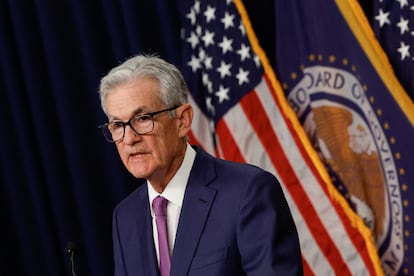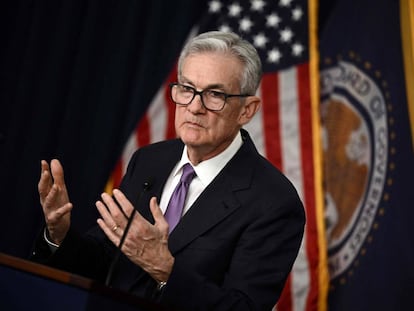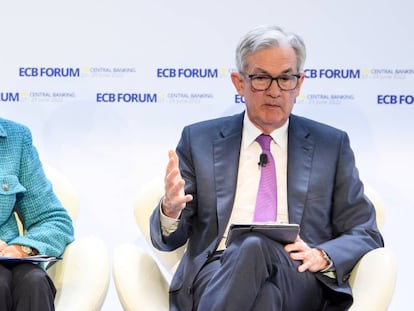The Federal Reserve maintains its plan to lower interest rates three times by the end of the year
The US central bank is keeping the price of money at 5.25%-5.5% for now, the highest in 23 years


The roadmap remains unchanged. Members of the Federal Reserve’s Federal Open Market Committee (FOMC) expect interest rates to fall 0.75 points by year’s end from the current level of 5.25%-5.5% to 4.625% (i.e., in the 4.5%-4.75% range), according to forecasts updated Wednesday. Assuming that the central bank will gradually take steps toward a less restrictive monetary policy, that would mean three 0.25-point cuts. Analysts and investors expect those cuts to come at a quarterly pace starting at the June 11-12 meeting, the last meeting of the spring. However, the Fed expects a somewhat less forceful rate cut in 2025: three 0.25-point cuts instead of four. As expected, at Wednesday’s meeting rates were held at a 23-year high, and the central bank appears to have ruled out a cut by May 1.
Fed Chairman Jerome Powell made it clear at the post-meeting press conference that there is risk on both sides. “The risks are really two-sided here… We’re in a situation where if we ease too much or too soon, we could see inflation come back. And if we ease too late, we could see unnecessary harm to employment. We want to be careful and fortunately with the economy growing, the labor market strong and inflation coming down, we can be,” he said, summing up his position.
Powell did not want to completely rule out a first rate cut in May, because a lot can happen between meetings, but he implied that it would be too soon in the current circumstances. He also warned that if inflation is not contained, “we are prepared to maintain the current target range for the federal funds rate for longer, if appropriate.”
The Federal Reserve publishes its forecasts at each quarter’s last meeting. They have a qualified value because those who formulate them are basically the ones who have to decide, although they do not commit to their actions and often deviate from reality. All 19 FOMC members give their opinion, not just the 12 who are entitled to vote under the rotating system.
In December, the median forecast was that rates would be at 4.625% by the end of 2024 (equivalent to a range of 4.5% to 4.75%), as they are at present. However, they then expected them to fall again in 2025 by one point to 3.625%, but they remain at 3.875% (3.75%-4% range), which implies a cut of only 0.75 points. The same is true for 2026: previously they expected 2.875% and now 3.125%. In short, they are eliminating a 0.25-point cut in 2025 in light of the sense that the fight against inflation is dragging on. There is some divergence in the forecasts, and we don’t know whose they are, so there is room for uncertainty, especially since 9 of the 19 members of the Committee expect fewer cuts this year than those 0.75 points.
Investors have become increasingly resigned to a slower pace of cuts than they expected just two months ago, and ahead of Wednesday’s meeting, the implied futures market prices have been adjusting to expectations of three 0.25-point cuts for the rest of the year.
The fact that inflation has not fallen below 3% has complicated and put off rate cuts. At the same time, the labor market has shown some signs of relative cooling off within the general buoyancy of recent years. This puts Powell in a difficult position, with risks on both sides: of lowering rates too soon and too fast and undermining the fight against inflation, and of lowering them too late or too little and triggering a recession.
In keeping with its dual mandate of maximum long-term employment and price stability (understood as 2% inflation), monetary policy’s current objective is to achieve a soft landing for the economy, i.e., a weakening of demand sufficient to contain prices without triggering a full-blown recession. So far, Powell has accomplished this, but he is still not declaring victory.
At the January meeting he made it clear that no rate cuts were imminent. At the time, the Fed statement noted that “the Committee does not expect it will be appropriate to reduce the target range until it has gained greater confidence that inflation is moving sustainably toward 2 percent.” That sentence remains in Wednesday’s statement, so a cut at the April 30-May 1 meeting is unlikely. Between now and then there will only be one more monthly inflation and job creation report (for March), which seems meager for a Fed that claims to be data driven. The April and May data will be known by the meeting that ends on June 12, so the picture will be clearer then.
A soft landing
Powell began his appearance on Wednesday with optimism, which central bankers don’t often express: “The economy has made considerable progress toward our dual mandate objectives” of price stability and maximum possible employment, he said. “Inflation has eased substantially while the labor market has remained strong, and that is very good news.”
The scenario that the forecasts predict is a soft landing for the economy, which, according to the Committee members, would grow by 2.1% this year and 2% in the next two years, considerably more than what they previously expected (1.4%, 1.8% and 1.9% in those three years), in line with the good performance observed so far.
The unemployment rate would stand at 4.0%, 4.1% and 4.0% at the end of each year, somewhat lower than expected and marginally higher than the current 3.9%. At the same time, inflation would fall to 2.4% at the end of this year, to 2.2% in 2025 and the desired stability target of 2% in 2026, in line with previous forecasts.
Sign up for our weekly newsletter to get more English-language news coverage from EL PAÍS USA Edition
Tu suscripción se está usando en otro dispositivo
¿Quieres añadir otro usuario a tu suscripción?
Si continúas leyendo en este dispositivo, no se podrá leer en el otro.
FlechaTu suscripción se está usando en otro dispositivo y solo puedes acceder a EL PAÍS desde un dispositivo a la vez.
Si quieres compartir tu cuenta, cambia tu suscripción a la modalidad Premium, así podrás añadir otro usuario. Cada uno accederá con su propia cuenta de email, lo que os permitirá personalizar vuestra experiencia en EL PAÍS.
¿Tienes una suscripción de empresa? Accede aquí para contratar más cuentas.
En el caso de no saber quién está usando tu cuenta, te recomendamos cambiar tu contraseña aquí.
Si decides continuar compartiendo tu cuenta, este mensaje se mostrará en tu dispositivo y en el de la otra persona que está usando tu cuenta de forma indefinida, afectando a tu experiencia de lectura. Puedes consultar aquí los términos y condiciones de la suscripción digital.
More information
Archived In
Últimas noticias
Welcome to the post-religion era: The idea of Christianity as the absolute truth has become obsolete
‘I thought you would like it’: The risky sexual practice popularized by TV shows and TikTok
The digitalization of tourism: ‘They promise experiences and gave us the worst possible one’
Mexican peso defies uncertainty with forecasts of a new period of stability in 2026
Most viewed
- Sinaloa Cartel war is taking its toll on Los Chapitos
- Oona Chaplin: ‘I told James Cameron that I was living in a treehouse and starting a permaculture project with a friend’
- Reinhard Genzel, Nobel laureate in physics: ‘One-minute videos will never give you the truth’
- Why the price of coffee has skyrocketed: from Brazilian plantations to specialty coffee houses
- Silver prices are going crazy: This is what’s fueling the rally










































